mieducation
Zest for Biofilm Management: Improving Dry Eye Symptoms in Minutes
Ever wanted a dry eye treatment that can give improvements within minutes? In this article, optometrist Dr Leigh Plowman discusses the science and benefits of Zest for dry eyes, blepharitis, and ocular surface pain.
WRITER Dr Leigh Plowman
LEARNING OBJECTIVES
On completion of this CPD activity, participants should be able to:
1. Understand the role of bacteria in biofilm formation in ocular surface disease,
2. Understand clinical signs that indicate biofilm in the eye,
3. Learn about an enzymatic-like biomechanical process called Zest, and
4. Understand the role of Zest with at home therapies.
Imagine the patients with the worst eyelid margin debris in your practice. You can probably name them without too much effort.
They are the patients who have significant blepharitis, hordeola, chalazia, and dry eyes.
Bacteria play a significant role in several ocular surface diseases, including dry eye disease, hordeola, chalazia, and other inflammatory conditions.1
Bacteria produce an extracellular matrix called biofilm. Similar to plaque on our teeth, biofilm is made of proteins, DNA and polysaccharides. Biofilm is designed to protect the bacteria from antibiotics and immune cells.2 Biofilm on our eyelids and ocular surface causes inflammation and damage.
Biofilm is known to vary between bacterial species, or with changes in the environment. Some people tend to suffer from it more than others. Biofilm often goes undetected until it is abundant on the eyelids. It tends to slowly invade the lid margin, meibomian glands, palpebral conjunctiva, and fornices.3 The longer that biofilm rests on the eyelids, the greater the potential for ocular surface inflammation, damage and neurosensory abnormalities such as neuropathic pain.4
WHAT IS ZEST?
Zest is an in-office treatment created by the ophthalmologist, Dr Peter Pham. This simple, office-based treatment uses a specialised gel and cleaning swab to gently lift and remove biofilm through an enzymatic-like biomechanical process that does not induce further tissue injury. Clinical improvements in signs and symptoms are often felt within minutes. No additional equipment or anaesthetic eye drops are required.
Zest is based on okra polysaccharides (or complex sugars) derived from fresh okra. It also contains the following ingredients to add to chemical stability and performance:(natural ingredients and emollients) aloe vera leaf juice, hydrolysed soy protein, caffeine, citrus unshiu peel extract, and raspberry seed oil; (wetting agents) carboxymethyl cellulose and glycerin; (preservatives) ethylhexylglycerin, and phenoxyethanol; (surfactants) decyl glucoside and disodium cocoamphodiacetate. It also includes the chelator sodium phytate and sodium chloride solution.

The Zest kit.
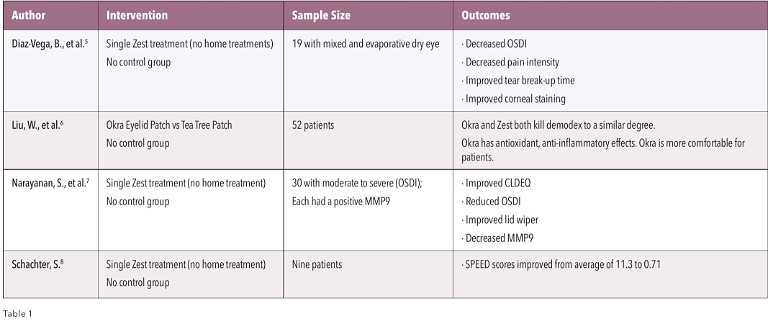
THE PUBLISHED EVIDENCE FOR ZEST
The exact mechanisms of Zest are still to be established. Like many other dry eye treatment options, there are no randomised controlled studies in the literature. Several studies performed a single Zest treatment. No home treatments were prescribed. That is, patients ceased artificial tears, warm compresses, lid hygiene, and other dry eye therapies. The researchers measured the clinical results over a period of hours, one week , one month or two months.
Table 1 shows four published studies to date.
In my clinical practice, I have noticed a significant improvement for my patients, which aligns with the published clinical trials.
Biofilm is present on a significant number of patients. You may notice subtle signs such as:
• Eyelid saponification ( bubbles along the lower lid margin or nasal/temporal canthal area),
• Tenting of eyelash bases (analogous to dirt around the base of a tree),
• Soft white buildup running in a line along the openings of the meibomian glands,
• Increased reflections at the base of the lashes,
• Staining on the superior conjunctiva or limbal area (SLK ),
• Superior and/or inferior eyelid collarettes, and/or
• Gunky debris on eyelashes.
WHICH PATIENTS BENEFIT MOST?
Zest appears to be most beneficial for patients with:
• Clinically significant dry eye symptoms with standard patient evaluation of eye dryness (SPEED) scores of >9 or OSDI >25,
• Significant demodex collarettes observed at the lash base,
• Intense pulsed light (IPL) patients where Zest is performed before and on the same day as the first session of IPL.
• Acute hordeola (to remove the inciting biofilm cause and to help with discomfort).
• Recurrent erosions where eyelid margin health plays a critical role in helping to restore basement membrane integrity.
“ This simple, of ficebased treatment uses a specialised gel and cleaning swab to gently lift and remove biofilm through an enzymatic-like biomechanical process that does not induce further tissue injury ”
HOW IS ZEST ADMINISTERED?
Zest is applied with the patient seated in the consultation chair. To begin, patients lean their head back against the chair. They close their eyes. Zest gel is lightly spread around the eyelids (I normally spread the gel around the eyebrow and orbit to remove more biofilm and demodex). Zest requires no anaesthetic.
The gel is then spread across the eyebrow and eyelid area with a gentle sweeping motion. Microsponge applicators are included for each upper and lower eyelid. The microsponge is swept back and forth, and also rotated to give extra debridement.
The treatment is normally applied for around three minutes for the upper lid and brow area, then rinsed with sterile saline included in the pouch. The area is dried. The treatment is then applied to the lower lid area for around two minutes before being rinsed and dried.
MEASURING CHANGE
Patients love seeing the improvement in their eyes. I like to record a baseline symptom level before treatment. I do a dry eye symptom SPEED score, which can be found online. Alternatively, you can ask your patient to choose their worst dry eye symptom and rate it out of a maximum of 10.
I take photos of patients’ eyes before and after the application of Zest with the slit lamp at around 16x magnification. I get good results with my iPhone 11 Pro Max with a Carson Telescope Mount (HookUpz) connected to an eyepiece.
After the treatment, I like to ask patients to do the SPEED score or rate their symptoms a second time. Patients often say that their eyes feel refreshed. Some patients say that their visual acuity is significantly improved, even with their best spectacle correction.
ONGOING CARE
Applying Zest is analogous to tartar removal at a dental checkup. Patients need to treat their eyelids at home (like brushing their teeth twice daily). To enable this, Zest has a home version including ZocuFoam (foam based) and ZocuWipes (eyelid wipes). Hypochlorous acid sprays such as Avenova, Hychlor or Heyedrate may be used as a substitute home treatment.
For patients with moderate-to-severe biofilm or demodex , ZocuShield gel is available. Patients can choose either to use ZocuFoam or ZocuWipes twice daily, leaving it on for one minute before rinsing well with water and drying off. ZocuShield gel should then be gently rubbed into the upper and lower eyelids. Patients can either leave it to dry, or rinse off after five minutes. Some patients prefer to do one or the other.
“ Additionally, Zest can significantly improve pain in ocular surface diseases such as episcleritis, conjunctivitis, keratitis, or other ocular surface conditions ”
COMBINING TREATMENTS
Zest is a great tool for patients with an active hordeolum or chalazion: for some, Zest and home therapy is enough to significantly reduce the size of the hordeolum or chalazion alone.
For others, I like to combine Zest with intense pulsed light (IPL) directly on the upper and lower eyelids. This protocol is known as the Periman Protocol.
Using Zest before IPL can offer a great combination treatment. Deep lid debridement with Zest can help IPL to work more effectively and bring symptom improvements faster. You can offer this combination to patients whether they are used for dry eyes and blepharitis, or chalazia/hordeola.
Additionally, Zest can significantly improve pain in ocular surface diseases such as episcleritis, conjunctivitis, keratitis, or other ocular surface conditions.
A PATIENT WITH SEVERE BLEPHARITIS
I wanted to share a story about one of my worst blepharitis patients. On each appointment he would come in saying he had a gritty sensation in the mornings. With treatment I hoped that one day he would say there had been a slight improvement. But each time, he would say that his eyes felt ‘about the same’.
At each visit I looked at the eyelids and lashes on slit lamp: nearly every eyelash showed collarettes and biofilm.
As I was looking on the slit lamp, I thought to myself, ‘How am I going to explain the debris and collarettes to him this time?’ Followed soon after by, ‘what else do we have that might actually work?’
This patient had tried Optimel drops and gel and tea tree cleansers with various concentrations.
I referred him to a colleague for BlephEx . At his review with me, I saw a slight improvement in his eyelids and lashes. But a couple of months later, his blepharitis was back to a similar level.
This patient was one of my first to try Zocular Zest. His improvements in clinical signs and symptoms were significant. He reported a significant improvement in the gritty sensation of his eyes.
This patient has regular appointments for diabetes and dry eye reviews. In the past three years, he has had more Zest treatments and home therapy for maintenance. He continues to feel a significant difference in the comfort of his eyes. Slit lamp shows close to zero collarettes or biofilm. Zest gives a significant improvement to dry eye symptoms and signs within minutes.
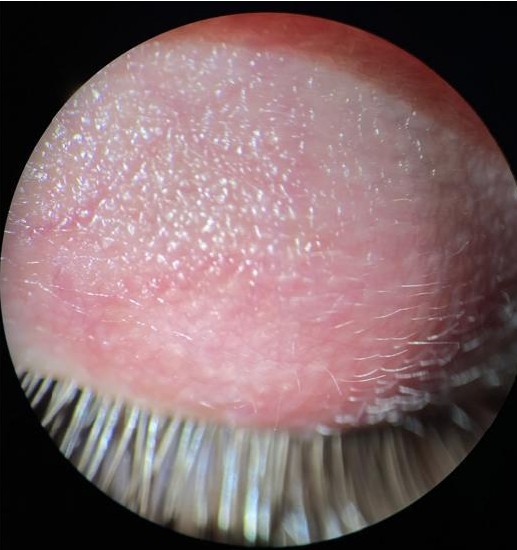
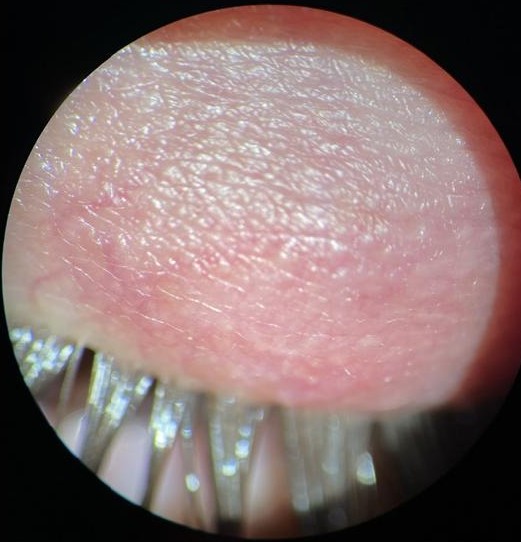
Slit lamp image before Zest treatment for left upper lid chalazion (L) and 31 minutes after Zest treatment (R). Note the significant reduction in hyperaemia, which was sustained a week later.
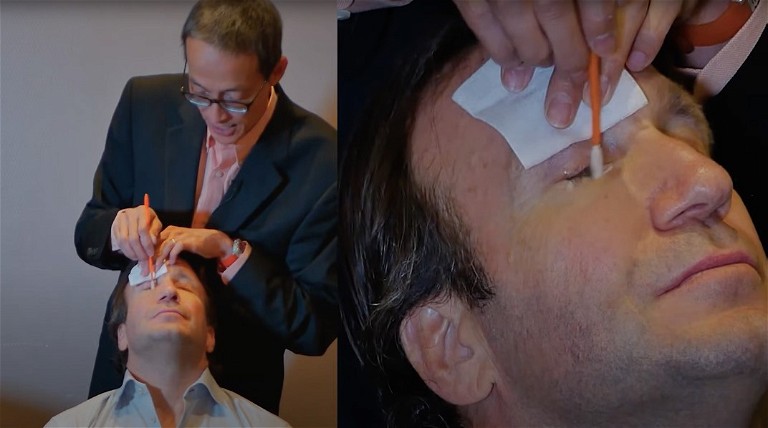
Demonstration of Zest application.
To earn your CPD hours from this article visit: mieducation.com.au/zest-for-biofilm-managementimproving-dry-eyesymptoms-in-minutes.
Zest is available from Good Optical Services.
Scan the QR code to watch a product demonstration.
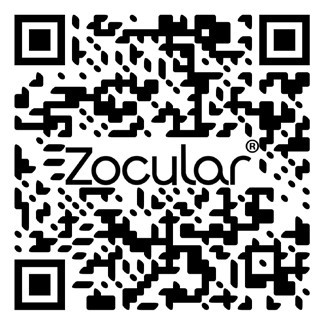
References
1. Nattis, A., Perry, H.D, Rosenberg, E.D., Donnenfeld, E.D., Influence of bacterial burden on meibomian gland dysfunction and ocular surface disease. Clin Ophthalmol. 2019 Jul 12;13:1225–1234.
2. Ali, A., Alatawy, R., Abid, M., Noorani, M.S., et al., Microbial biofilms: applications, clinical consequences, and alternative therapies. Microorganisms. 2023; 11(8):1934.
3. Rynerson, J.M., Perry, H.D., DEBS–a unification theory for dry eye and blepharitis. Clin Ophthalmol. 2016 Dec 9;10:2455–2467.
4. Craig, J.P., Tsubota, K., Stapleton, F., TFOS DEWS II definition and classification report. Ocul Surf. 2017 Jul;15(3):276–283.
5. Diaz-Vega, B., Rodriguez-Fabuel, C., Vitores-Mate, S., Carpena-Torres, C., Lid scrubbing with a gel combining natural extracts for dry eye treatment. Int J Ophthalmol. 2023 Jul 18;16(7):1053–1059.
6. Liu, W., Gong, L., Anti-demodectic effects of okra eyelid patch in demodex blepharitis compared with tea tree oil. Exp Ther Med. 2021 Apr;21(4):338.
7. Narayan, S., Meibomian gland dysfunction management with ZEST protocol. 2019. clinicaltrials.gov/study/
NCT03968731. 8. Schachter, S., Novel okra polysaccharide approach to inflammation control for dry eye. ARVO 6741-B0265 (2019).
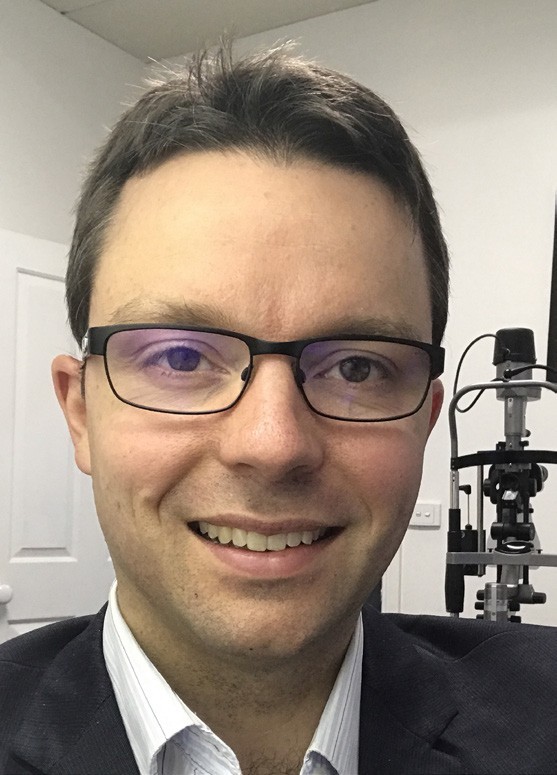
Dr Leigh Plowman BOptom (Therapeutics) is an optometrist at Otway Optical in Colac, Victoria. He is the founder of the Dry Eye Directory and frequently writes and presents on dry eye disease.